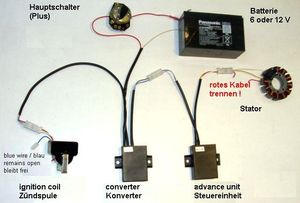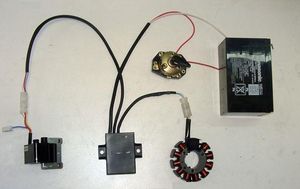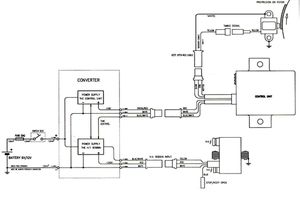Powerdynamo brings new ignition & light
to your vintage motorcycle
|
|
Powerdynamo brings new ignition & light |
|
||||
|
|
||||||
|
Difficult starting with magneto? |
You want to revert to battery ignition? |
|---|---|
|
|
|
| All our systems (except a few ignition only
units) are magneto based. Advantage is that ignition is independent of
battery. Some customers who have motorcycles originally equipped with
battery based ignitions, experience starting problems after converting to the
magneto. Any magneto, whether our system or whatever original magneto there was, needs a starting revolution speed to get spark. If the kick of the starter is too slow, spark might fail and multiple kicking might be required. |
|
|
|
|
|
Is there a way out? |
|
| For Powerdynamo systems based on external sensor technology we offer a simple solution. For internal sensor based systems this is unfortunately not possible (yet). | |
|
|
|
| On our magneto systems the power feeding the spark is generated in the larger black coil under the influence of the turning magnets. This energy is fed through the red wire to the ignition coil. On systems with advance unit it will pass on its way there the advance unit to get delayed in function of crank speed. | |
|
|
|
| In the proposed solution this feed from the
magneto is replaced by a feed from the battery. That can however
not be done directly as the systems ignition parts expect a very high
and special voltage normally generated by the magneto (over 300 Volts). We offer an add-on converter module which converts the battery voltage (any voltage between 5 and 17 Volts) to some voltage that is making the ignition parts believe that this is feed from the magneto. The unit is housed in a box identical to the advance unit, but had a totally different function and internal build. It is plugged onto the existing Powerdynamo without problem as its plugs will match the plugs existing there. On our 4-stroke systems you need to cut and insulate the red wire from the magneto (insulated as the magneto still produces voltage). If you forget to disconnect that wire the system will not work and electronics are liable to be destroyed. For our 2 stroke systems there is no need to cut the wiring. We deliver the module already wired in a way that the red cable will not be lead through (the red wire from the stator will end in a plug position from where there is no continuation). |
|
|
|
|
|
Wiring for systems with advance unit ... |
... and without advance unit! |
|
to enlagre, please click pictures |
|
 |
 |
|
technical wiring 4-stroke |
technical wiring 2-stroke |
 |
|
| part no: 70
80 599 50 Price and availability see here |
part.no: 70
32 599 50 Price and availability see here |
|
enlarge wiring information by clicking on the pictures |
|
|
|
|
| This unit consumes energy. At 7000
sparks per minute (7000 revs on single and 3500 on twin) it will take 3.3A
in a 6V system and 1.4A in a 12V system. This is about the same a
classical battery based system takes. The unit should not be operated in temperatures above 50 degrees. The unit will heat up during operation of up to 30 degrees. Especially on twin engines or double spark engines with high revolutions, please place the unit into a place with direct airflow to cool it. Do not hook it together with the regulator or the advance unit. Do not place it close to engine heat. Do not connect directly to the battery, always via the main switch of the motorcycle. Otherwise it might drain your battery empty after a few days at standstill. |
|
|
|
|
| Last words: Starting difficulties may have plenty of reasons, notably carburettor problems, wrong ignition timing, leaking oilseals (on 2 strokes) and a dozen of other factors. | |
|
|
|